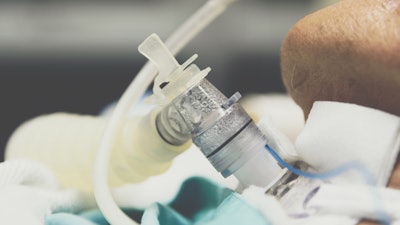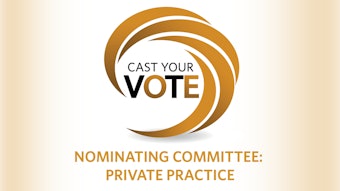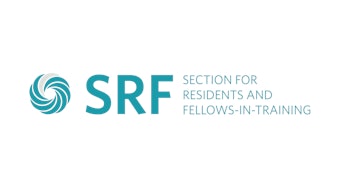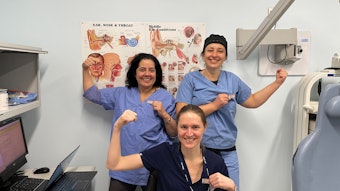From the Education Committees: Tracheostomy Care
Tracheostomies are one of the most-performed surgical procedures, and the incidence has continued to rise.
Lacey K. Adkins, MD, Laryngology and Bronchoesophagology Education Committee member
 Lacey K. Adkins, MD
Lacey K. Adkins, MD
Tracheotomy care begins in the immediate postoperative period. Tracheostomy ties should be used unless there is a surgical contraindication such as free flap reconstruction. Velcro or twill ties may be used with no consistent difference in skin-related complications or decannulation rate.1 Stay sutures may decrease the incidence of accidental decannulation in fresh tracts.2,3 They should be tied with air knots and removed within seven days to avoid excess pressure and resulting pressure ulcer formation.
Pressure ulcers occur in 10%-30% of tracheostomies.4,5 Having a set tracheostomy care protocol, especially one that involves a multidisciplinary team to identify and provide wound care, helps reduce their incidence. Moist dressings applied peristomally result in a lower incidence of pressure ulcers, shorter wound closing times, and less frequent dressing changes.6
In the early postoperative period, secretions are more copious. Frequent suctioning and care with saline flushes as needed are key to avoiding mucous plugging.7 Humidification should be used to help mobilize secretions. Prior to cuff deflation and tracheostomy change, the tracheostomy and stoma should always be suctioned.8

Early involvement of a speech-language pathologist leads to earlier phonation and transition to an oral diet. Some patients can tolerate early cuff deflation and in-line speaking valve placement while still receiving mechanical ventilation safely.11,12 Once off mechanical ventilation, the cuff should be deflated or the tracheostomy changed to an uncuffed tube to decrease further tracheal pressure injury.8 This also allows for phonation with a one-way speaking valve. If the patient has an appropriately sized tube and is unable to tolerate the valve, the upper airway needs to be examined to evaluate for any abnormalities. If they can tolerate a valve but the voice is soft, a fenestrated tracheostomy tube may allow more air to reach the glottis. However, they require close monitoring as patients can develop granulation tissue at the site of fenestration that needs to be managed before leading to airway obstruction.13 One could argue that the choice of a fenestrated tracheostomy would be best made with the consultation of an otolaryngologist.
For patients who require long-term tracheostomy dependence, biofilms and the tracheal environment eventually lead to hardware degradation. Frequent tracheostomy change may result in less granulation tissue formation. Tracheostomy manufacturers have recommended changing intervals with their products, which is usually one month. In the literature, there is extensive variability on recommended intervals ranging anywhere from two weeks to every three months and especially whenever the tube begins to change color or has visible degradation or cracks.14,15
For weaning and decannulation, having a set protocol leads to a higher rate of decannulation during the hospital stay and a decreased time to decannulation.9,16 Before decannulation, the patient should no longer require mechanical ventilation and have no further procedures planned, an intact cough reflex and an appropriate mentation and laryngopharyngeal function to protect themselves from aspiration. A capping trial should then be started with an uncuffed, appropriately small tube in place and may last anywhere from 24 to 72 hours depending on surgeon preference. The upper airway should be examined prior to decannulation as well by at least laryngoscopy and tracheoscopy. In patients who tolerate capping trials for 24 hours, up to 20% have lesions on endoscopy that are a contraindication to decannulation.17
After decannulation, follow-up is needed to assess for tracheacutaneous fistula closure and to monitor for any stenosis symptoms. Roughly 1%-2% of patients will report symptoms of benign tracheal stenosis after decannulation, whether from scarring, tracheomalacia, or A-frame deformity, usually after a delay of two to three months.18
In conclusion, tracheostomy is an increasingly common procedure that has extensive care associated with it. The biggest step to take toward improving outcomes is to establish a multidisciplinary tracheostomy team that follows the patient in the hospital as well as a plan for follow-up post discharge. With non-otolaryngologists performing tracheostomies, the otolaryngologist has an important role to play in follow-up planning. This helps to facilitate appropriate wound care, progression toward decannulation, and patient/caregiver education.
References
1. Chang BA, Gurberg J, Ware E, Luu K. Velcro ties in early postoperative pediatric tracheostomy care: a systematic review and meta-analysis. Otolaryngol Head Neck Surg. 2020. doi:10.1177/0194599820964727
2. Lee SH, Kim KH, Woo SH. The usefulness of the stay suture technique in tracheostomy. Laryngoscope. 2015;125(6):1356-1359.
3. Fine KE, Wi MS, Kovalev V, Dong F, Wong DT. Comparing the tracheostomy dislodgement and complication rate of non-sutured neck tie to skin sutured neck tie fixation. Am J Otolaryngol. 2021;42(1):102791.
4. Carroll DJ, Leto CJ, Yang ZM, et al. Implementation of an interdisciplinary tracheostomy care protocol to decrease rates of tracheostomy-related pressure ulcers and injuries. Am J Otolaryngol. 2020;41(4):102480.
5. Baker LR, Chorney SR. Reducing pediatric tracheostomy wound complications: an evidence-based literature review. Adv Skin Wound Care. 2020;33(6):324-328.
6. Yue M, Lei M, Liu Y, Gui N. The application of moist dressings in wound care for tracheostomy patients: a meta-analysis. J Clin Nurs. 2019;28(15-16):2724-2731.
7. Masood MM, Farquhar DR, Biancaniello C, Hackman TG. Association of standardized tracheostomy care protocol implementation and reinforcement with the prevention of life-threatening respiratory events. JAMA Otolaryngol Head Neck Surg. 2018;144(6):527-532.
8. Mitchell RB, Hussey HM, Setzen G, et al. Clinical consensus statement: tracheostomy care. Otolaryngol Head Neck Surg. 2013;148(1):6-20.
9. Mussa CC, Gomaa D, Rowley DD, Schmidt U, Ginier E, Strickland SL. AARC clinical practice guideline: management of adult patients with tracheostomy in the acute care setting. Respir Care. 2021;66(1):156-169.
10. Cherney RL, Pandian V, Ninan A, et al. The Trach Trail: A systems-based pathway to improve quality of tracheostomy care and interdisciplinary collaboration. Otolaryngol Head Neck Surg. 2020;163(2):232-243.
11. Sutt AL, Cornwell P, Mullany D, Kinneally T, Fraser JF. The use of tracheostomy speaking valves in mechanically ventilated patients results in improved communication and does not prolong ventilation time in cardiothoracic intensive care unit patients. J Crit Care. 2015;30(3):491-494.
12. Freeman-Sanderson AL, Togher L, Elkins MR, Phipps PR. Return of voice for ventilated tracheostomy patients in ICU: a randomized controlled trial of early-targeted intervention. Crit Care Med. 2016;44(6):1075-1081.
13. Pandian V, Boisen S, Mathews S, Brenner MJ. Speech and safety in tracheostomy patients receiving mechanical ventilation: a systematic review. Am J Crit Care. 2019;28(6):441-450.
14. White AC, Kher S, O'Connor HH. When to change a tracheostomy tube. Respir Care. 2010;55(8):1069-1075.
15. Backman S, Bjorling G, Johansson UB, et al. Material wear of polymeric tracheostomy tubes: a six-month study. Laryngoscope. 2009;119(4):657-664.
16. Farrell MS, Gillin TM, Emberger JS, et al. Improving tracheostomy decannulation rate in trauma patients. Crit Care Explor. 2019;1(7).
17. Rodrigues LB, Nunes TA. Importance of flexible bronchoscopy in decannulation of tracheostomy patients. Rev Col Bras Cir. 2015;42(2):75-80.
18. Zias N, Chroneou A, Tabba MK, et al. Post tracheostomy and post intubation tracheal stenosis: report of 31 cases and review of the literature. BMC Pulm Med. 2008;8:18.

















